Shab Neshini Dar Jahanam
aka A Party In Hell
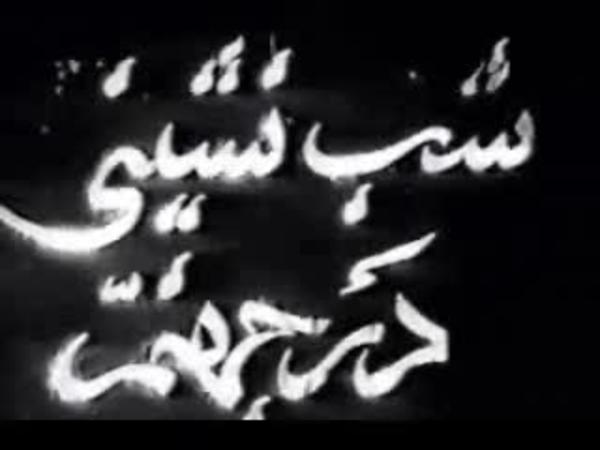
1958![]()
Written by Mehdi Maysaghieh
Directed by Samuel Khachikian and Mushegh Sarvarian
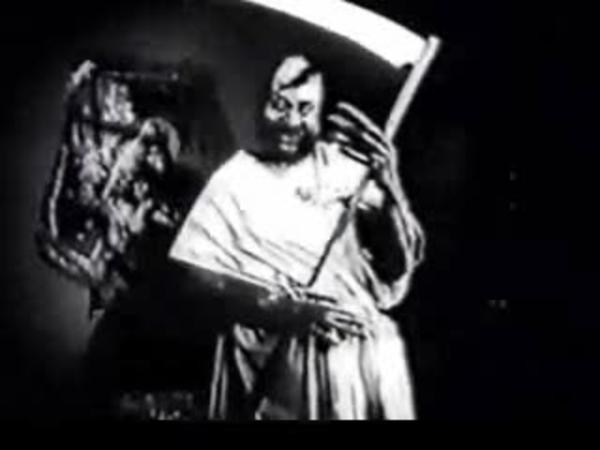
When you think Iranian cinema, what comes to mind for most people are art house movies that are considered critical masterpieces. Now, this may be true for most Iranian cinema exported post-revolution, but Iran has had a prolific and diverse cinema industry for over 100 years. Even the current crop of films produced for the domestic audience is completely different from the art house films (many of which are not even screened in Iran!) And like any thriving film community, excellent and influential directors will helm pictures that are now considered genre films. So we’re going to take a trip back to the 50s and 60s, when Iranian cinema was at one of its creative peaks. Around this time, the box office was beginning to fill up with thriller pictures that would become a fad before being replaced by melodramas as the next big thing. Western influences in storytelling and editing became more apparent, especially films directed by Samuel Khachikian, one of the directors of Shab Neshini Dar Jahanam (A Party in Hell).
The reason Shab Neshini Dar Jahanam gains our attention is the highly detailed and energetic fantasy sequence that makes up the last third of the film. Our hero wanders through Hell to learn important life lessons on not being a greedy jerk, and in doing so encounters wonderful sets, costumes, and historical figures. The wild underworld filled with angels, devils, tribesmen, dancers, Caesars, Hitler, Napoleon, Genghis Khan, snake ladies, giant monsters, a Satan Computer, and rock and roll, is a creative and entertaining feast. The use of movement and music flow together to create an energy that brings the film to life. Needless to say, I enjoyed A Party in Hell.
Two directors are credited in some database, others only list Samuel Khachikian. So let’s talk about him first. Khachikian was one of the most popular and influential directors in Iranian history. He was also a prolific writer and editor. Khachikian’s directing career started with 1953’s Return, and he went on to direct forty films. Many of his pictures would be classified as genre pictures, trending towards thriller and noir elements, with several featuring horror elements. His successful suspense pictures earned him the nickname “Iranian Hitchcock.”
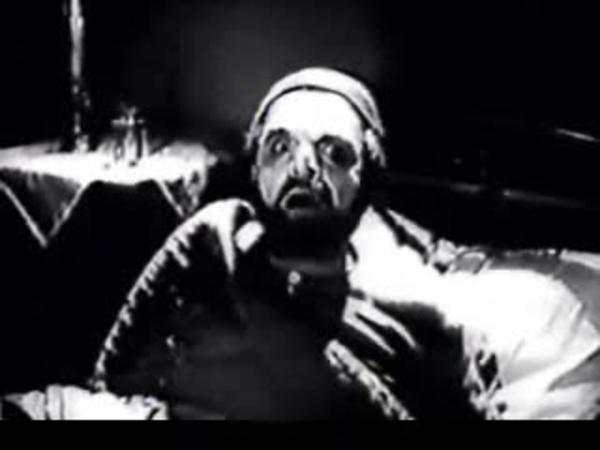
Some of his better known films are Khodahafez Tehran (Goodbye Tehran, 1966), Faryade nimeshab (The Midnight Terror, 1961), Delhoreh (Anxiety, 1962), and Chahar-rahe havades (The Crossroad of Events, 1955). Shab Neshini Dar Jahanam/A Party in Hell was entered into the 8th Berlin International Film Festival. Khachikian was Iranian-Armenian, and his original films were first shown within the community before expanded to all of Iran. Khachikian is also known for creating the first trailer for an Iranian film, his second feature, A Girl from Shiraz (1954).
Many of Khachikian’s films deal with class issues. His first film Return was a drama where a servant boy and the spoiled son from the family her works for compete over the affections of a young lady. He returned to the class themes with his third film, Crossroads of Incidents (1955), that also featured criminal scenes that got him praise. This continued into 1957’s A Storm in Our Town, a thriller that began his comparisons to Hitchcock. Khachikian would deny the influence, instead citing the stories from his father about the Armenian genocide as inspiration for the psychological thriller elements. Khachikian’s most well-known films were produced in the 60s, by the 1970s popular cinema had moved towards elements outside his comfort zone, leading to less distinctive work.
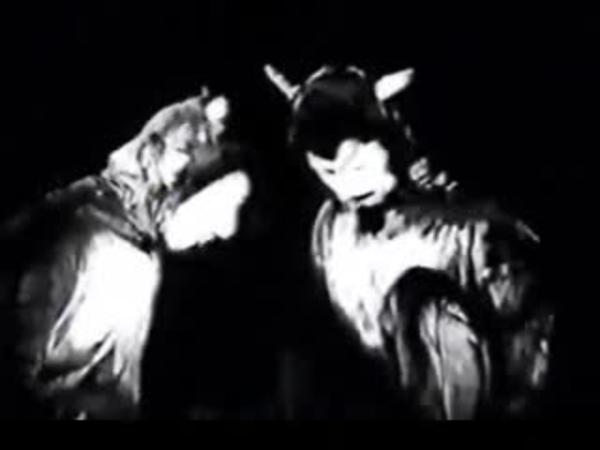
After the revolution, Khachikian’s output slowed considerably. 1985’s Eagles was one of the the first war films made by Iran, and was the highest grossing film up to that time. He wasn’t allowed to make another film until 1990’s Herald, a religious movie he made to placate Islamic cultural ministers (Khachikian was Christian.) Khachikian died in 2001, but his family legacy lives on through his son, director Edwin Khachikian, and his grandson, editor Ara H. Keshishian.
Mushegh Sarvarian was the original director, but for reasons I was unable to figure out, he left the production, causing the producers to scramble and hire on Khachikian. Sometimes known as Mushegh Soruri, the Iranian/Armenian director helmed a few other films, Mahtabe khoonin (aka The Bloody Moonlight, 1956), Haji Jabbar dar Paris (aka Mr. Jabbar in Paris, 1961), and Shahname akharesh khoshe (1966). I am pretty sure Haji Jabbar dar Paris is a loose sequel, with Ezzatollah Vosoogh reprising the role of Haji Jabbar. There isn’t that much information out there about Mushegh Sarvarian in English. If I were to guess, I would say Mushegh Sarvarian directed the more comedic elements of A Party in Hell and Samuel Khachikian directed the effects-laden portions.
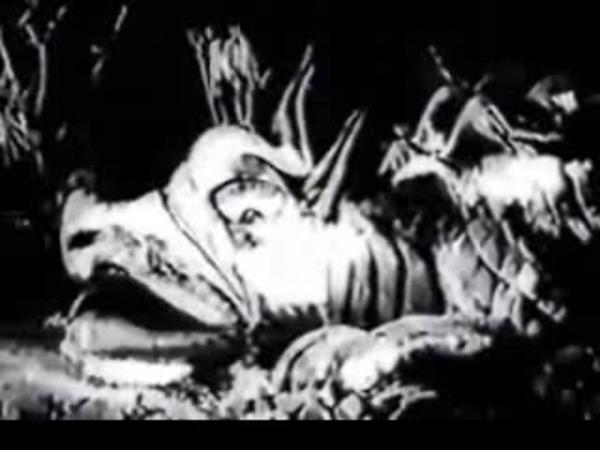
Aside from the actors I’ve identified, I’ve found the cast list containing Roomina, Parkhideh, Rahim Rohshanian, Hooshang Morahdi, Akbar Khajavi, Ebrahim Bahgheri, Mehdi Raisfirooz, Berenji, Sobhani, and Zarandi. I don’t know who is who, beyond suspecting Roomina is Parvin.
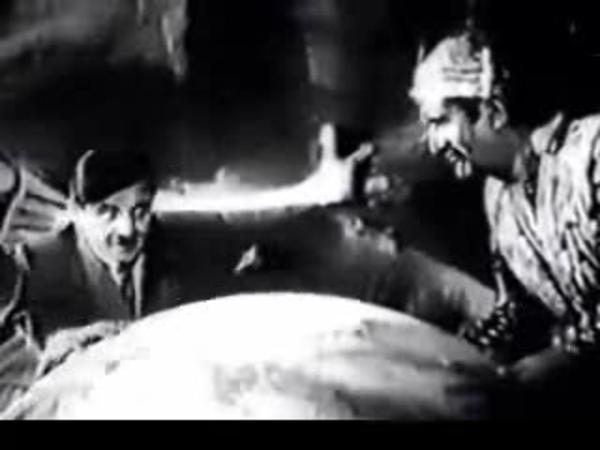
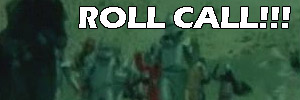
|
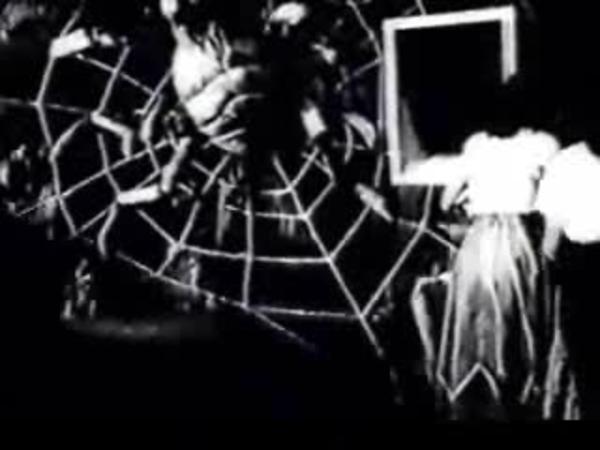
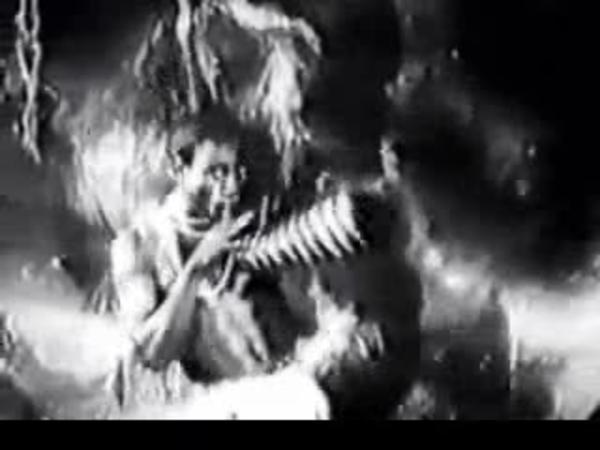
Are we really watching an Iranian film? Because it starts out with some very stereotypical (aka racist) African natives playing a horn and tribal dancing with flame sticks. We see where this is from much later in the film, but for now it’s a weird non sequitur before we’ve even gotten to the point to sequitur. The music is like a fast-paced Manos the Hands of Fate Theme with more clarinet and no guitar, with occasional brass accompaniment.
Haji is a greedy jerk, we know this because he’s too busy counting his money and mumbling to himself about how rich he is to pay attention to the morning call to prayer. We see him yell at his employees, yell at his assistant Ahmad, scream at beggars to take a hike, screaming at a widow and her children and tossing them out on the street, and continually counting his money. Basically he’s the reincarnation of Ebeneezer Scrooge except with awful old man makeup.
Haji’s daughter Parvin is in love with her cousin, which is perfectly normal, except her dad is scheming to marry her off to a rich old guy! Young love that cannot be in this unjust world. Now, you might be asking, can their hopeless love be expressed in song form? Yes! Plus we got accordions!
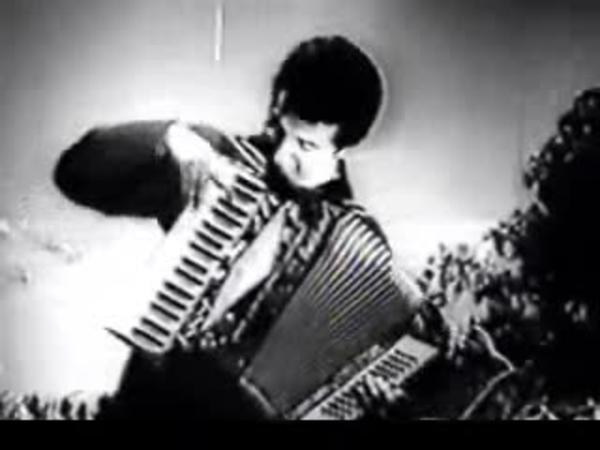
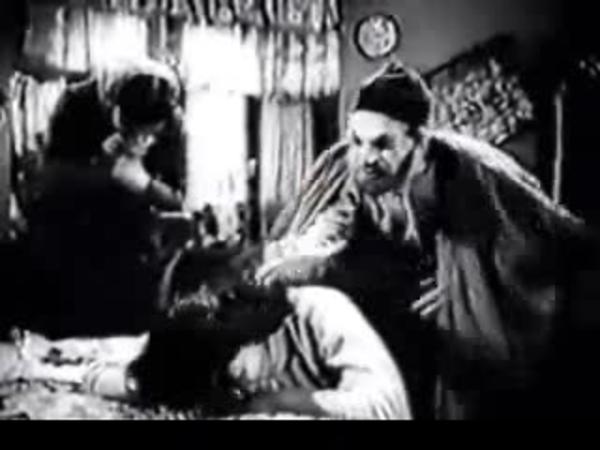
When Haji’s daughter and long-suffering wife tries to chide him for being greedy or try to get some freedoms, he berates them and even smacks and slams his daughter’s head into a table. What a nice man. Parvin was slammed so hard she sings a sad song, largely to her caged bird, which is a metaphor you don’t need subtitles to get.
Haji’s assistant Ahmad is stressed out to the point that he’s dressing up in a fake beard and a turban and going to play wind instruments at night clubs (while a belly dancer does what her name implies!)
I guess they needed to film some time before we go to Hell, so we have a sequence where a guy attempts to rob Haji’s house. Ahmad sees him and sneaks into the house behind him. There is a sequence where in the darkness, the thief unknowingly sits on Ahmad’s lap, and every stack of money the thief puts in his pockets, Ahmad then takes out. The whole sequence plays out like a type of Marx bros comedy, complete with the thief wearing a hat and outfit similar to what Chico wears all the time. There is also a lot of “BoING” sound effects for the slower members of the audience who don’t know this is supposed to be funny.
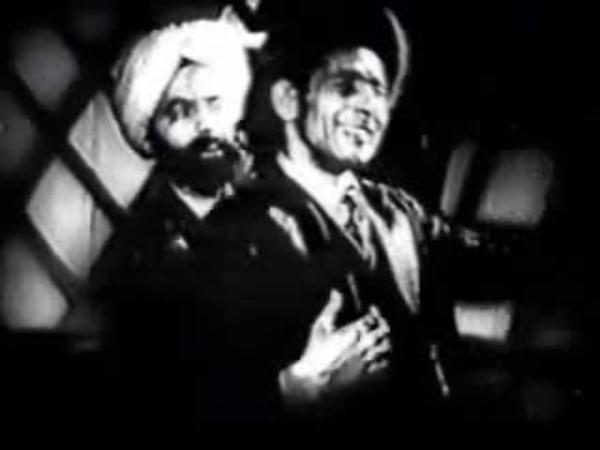
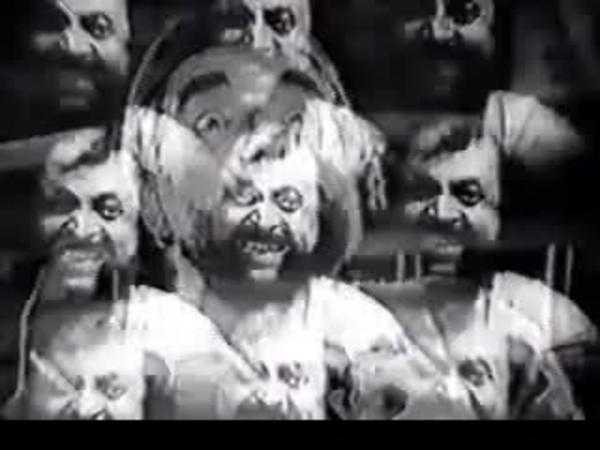
Poor Haji, now he’s sick. Sick! And being rich can’t make the sick go away. So it’s time for Haji to go off to slumberland, and thus Shab Neshini Dar Jahanam kicks into high gear!
Haji awakens to the sound of disembodied laughter. A man materializes in his room. But not really a man. And he’s holding a scythe. And he has long, sharp clawed fingers. It’s DEATH!!! He teleports around the room to intimidate Haji, because that’s how Death rolls. The teleporting becomes disturbing and then psychedelic in nature with insane laughter and fly-eye effects. This is all before the 60s hippie revolution made these sorts of scenes mainstream. But it is interesting to see how a freakout scene is built with a similar layout to what came later.
The freakout ends and Haji is in the middle of a forest. The film dips into The Wizard of Oz territory and has everyone he encounters be people he knows from life. First up is a weeping Tarzan guy and a Jungle Girl. The Tarzan is Parvin’s cousin, and he’s weeping because he cannot have the Jungle Girl, Parvin herself!
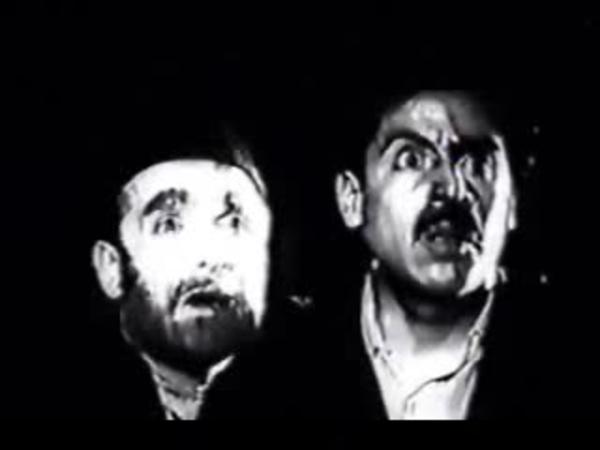
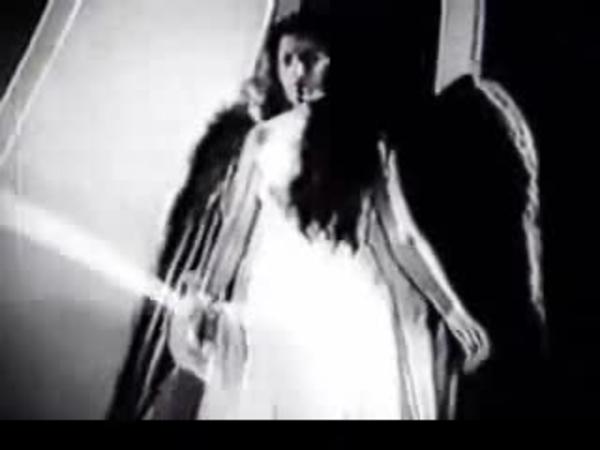
Haji continues wandering and runs across his assistant Ahmad, who shows him around the afterlife. There are impressive mountains and flames shooting into a lake of fire and Gothic architecture and giant bird statues…which looks very impressive, the only problem is the horrible quality copy of the film I have makes it so I can barely see the beauty of the set design! I don’t even know if a better version of this film still exists. Angelic voices on the soundtrack serve to give a false hope of Heaven, and also show the religious nature of what is being shown on screen. But we are not in Heaven, the only way to get into Heaven is via an impressive building that’s guarded by an Angel Lady, and she’s not too keen on Haji and Ahmad. She casts them away, and they must cross a very narrow bridge over a lake of fire to safety. They almost get all the way across, and then the Angel cuts the bridge and they fall and swing down into a cave.
Haji and Ahmad spot guys in devils suits gambling – the costumes look like devil pajamas complete with horned hoodies – but these are actual demons. They call Satan by the Satan Computer – a giant Satan-faced computer that looks awesome and beeps and has flashing lights. There are shots of people chained to a millstone being whipped and moaning, devils laughing atop giant creatures, all your classic Hell imagery. The giant creature some of the devils are on looks like a giant lizard, and it’s mouth opens to breath fire. I don’t know if it is supposed to be a creature, or is just part of the architecture, which is filled with statues and carvings.
Satan uses the Satan Computer to view the new arrivals. There are lots of African tribal dancing going on in Hell for some reason. Must be one of those fads. A dance number breaks out with sinful jazzy music and what looks like a topless babe taking center stage as our heroes gawk and wander into the number. The film is too washed out to tell if she’s actually topless or just pastied up. Either way, it’s a shocking amount of skin that I didn’t expect to see.
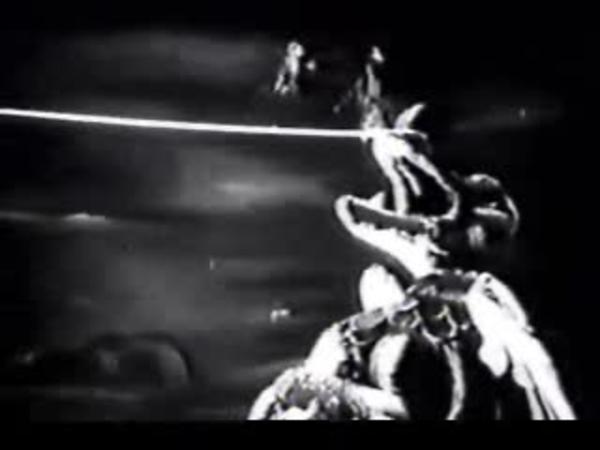
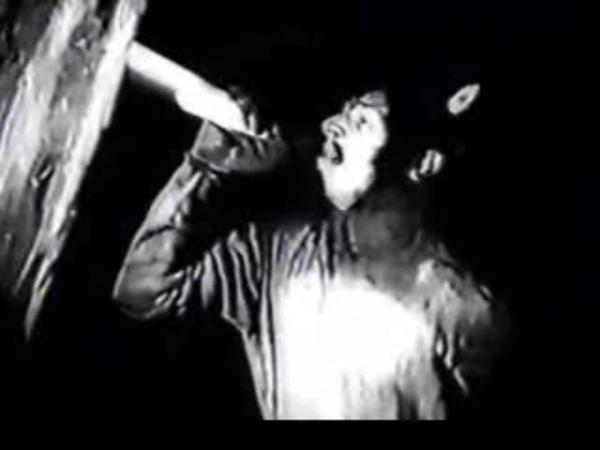
We get multiple scenes as Haji and Ahmad gawk and try to spot famous people in Hell, all while being occasionally pursued by the devils. They run across a Caesar who gives them a thumbs down.
The best sequence is when the soundtrack is still going jazzy and there is Hitler, Napoleon, and Genghis Khan obsessively and rhythmically circling a globe. They are so engrossed in their delusions of conquering the world that they don’t notice Haji and Ahmad grabbing some of their hats to try to blend in.
Next Hamid and Haji stumble across a rock and roll dance marathon as people boogie to a record. The set contains some awesome stationary giant spiders. The song playing is the classic tune Rip It Up, but it’s not the Elvis version nor the Bill Haley and his Comets version (though the cover is copying Haley’s version.)
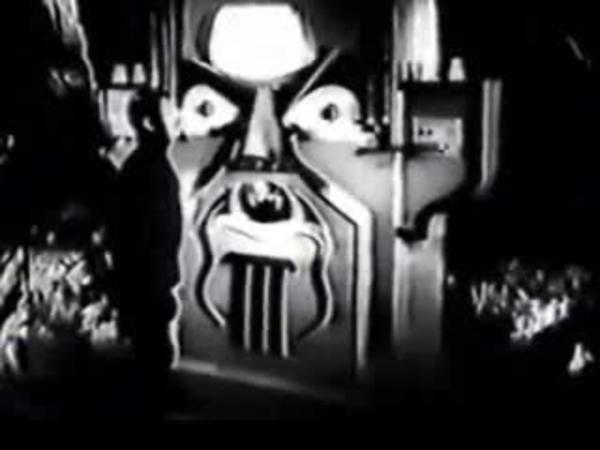
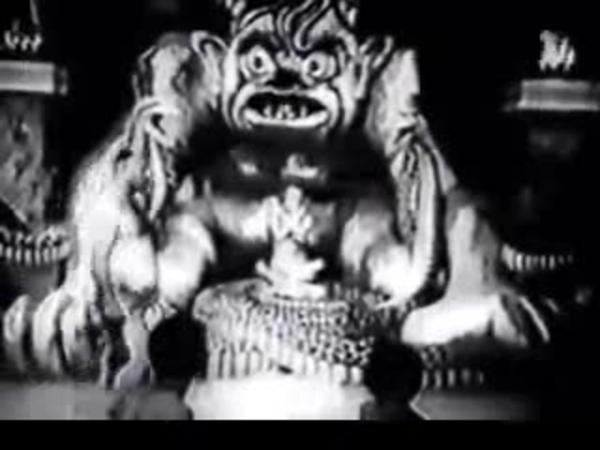
Ahmad and Haji are finally captured and brought to giant building. It turns out it is judgement time, and they get their day in court! I don’t know if this is like Defending Your Life or just a regular trial, because there is a chunk of the film missing and suddenly Haji is like a ghost and is seeing his burnt out daughter sing in a lounge.
God or whoever is in charge of the Hall of Judgement is making his rulings. Ahmad gets to go to Heaven, but Haji is a failure and gets turned into a dog! And the dog is then tossed into the furnace by the devils!
He made him…a hot dog!
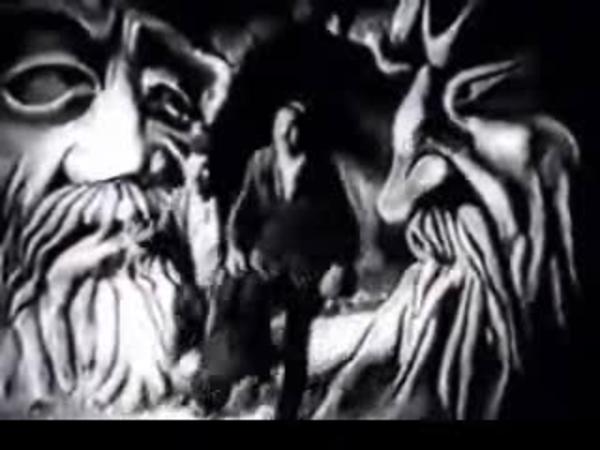
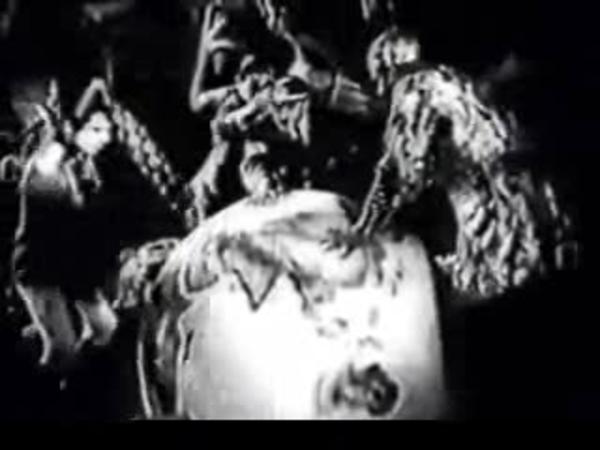
Don’t worry, it’s all a dream as Haji wakes up. He burst to the window and spots a child:
“You there, boy, what day is this?”
“Why, it’s Christmas Muslim Day!”
Okay, that exchange doesn’t happen. But Haji is a changed man. He tells the rich guy who came by to marry Parvin to take a hike! Parvin is free to marry whoever she wants. Ahmad is free to not get yelled at so much. And Haji gives some money to charity. At the end, when I guess he’s really dead, he gets a flying carpet ride in the sky straight into Heaven.
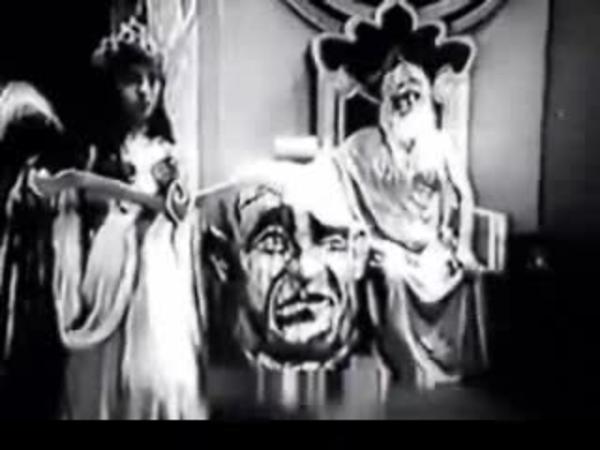
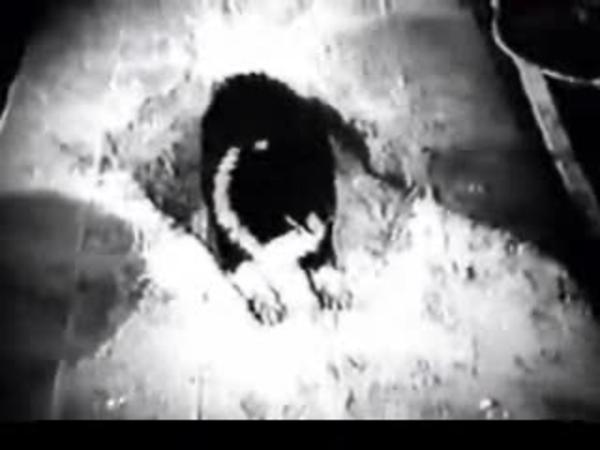
A Party in Hell is part of the MOSS conspiracy Satan’s School for Ghouls. Other entries include Seytan at Teleport City, The Tall Man at The Horror!?, and Hatimtai Ki Beti at FourDK.
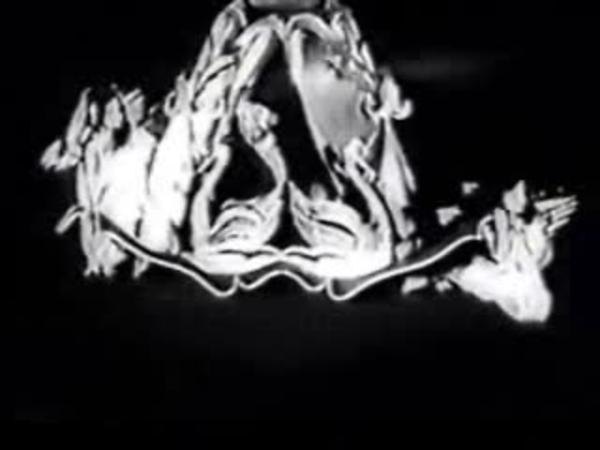
Rated 8/10 (giant beast, background spider, counting money, he’s no Chico, skull of death, eye of fly, even Zeus shows up!, Hail Caesar Salad!)
Please give feedback below!
Email us and tell us how much we suck!
Citations:
Iranicaonline
Onlinefilmhome
Asbarez
Payvand
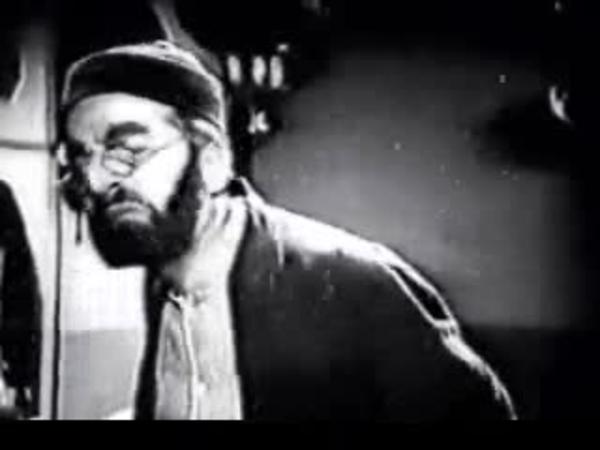
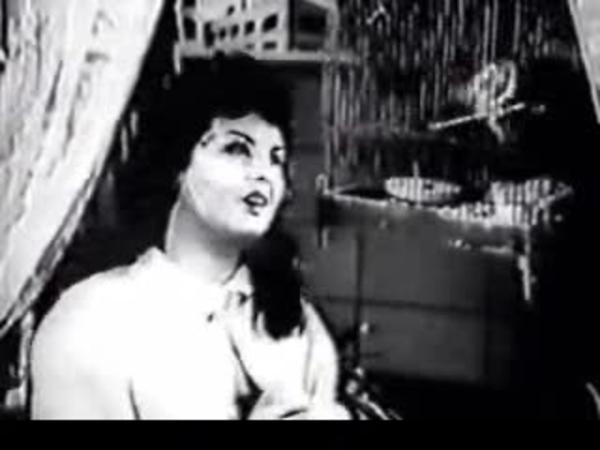
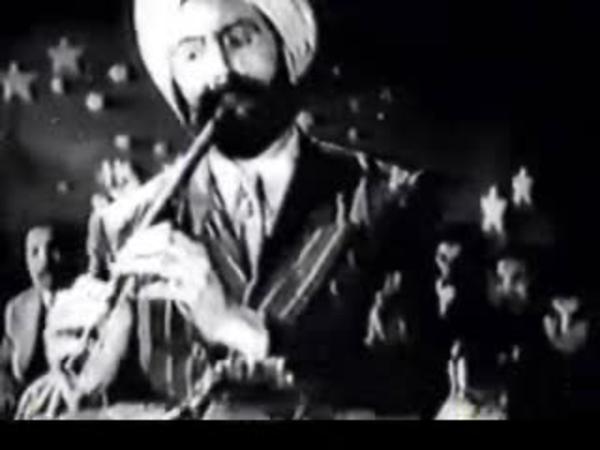
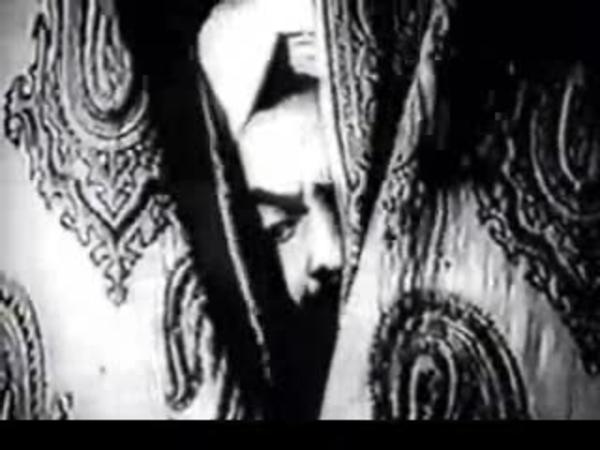

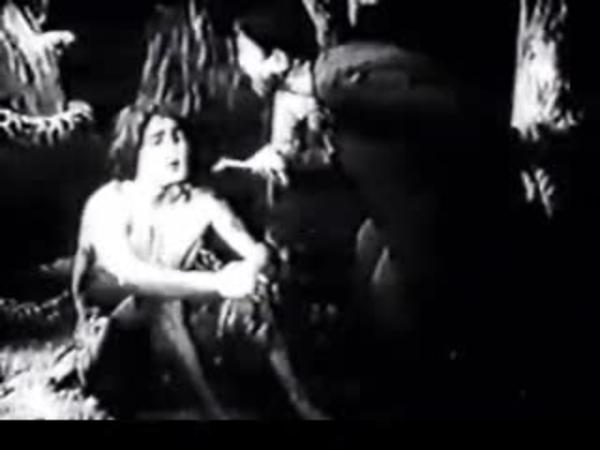
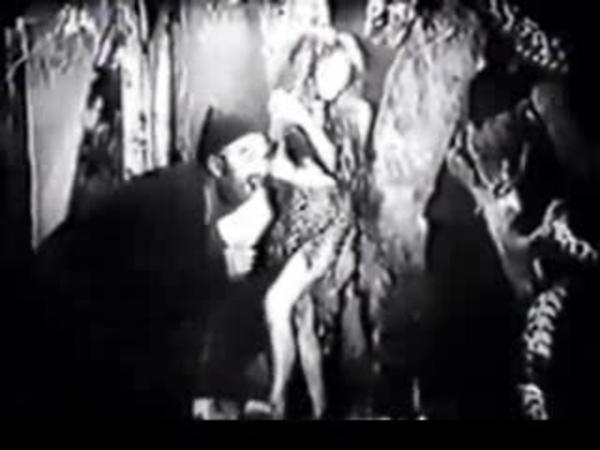
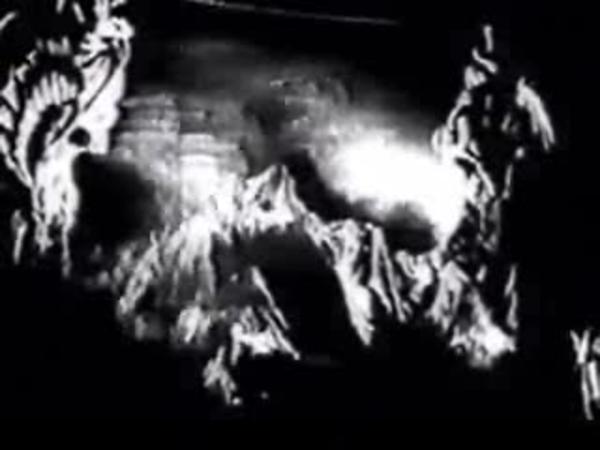
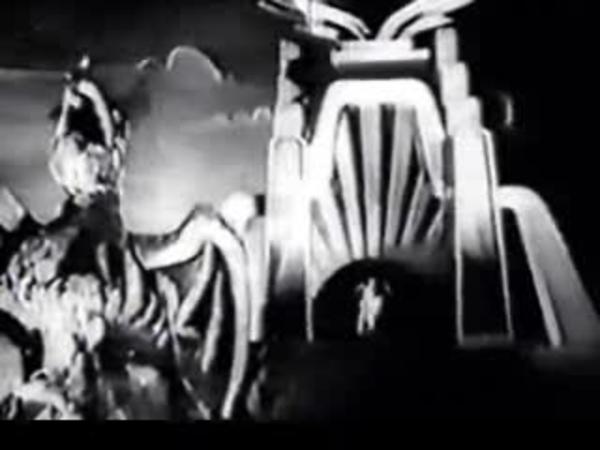
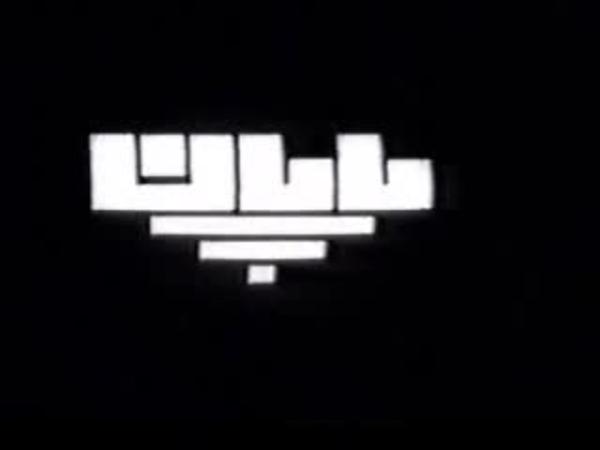


Pingback: The Large Association of Movie Blogs | Foreign Chops #7 – Iran